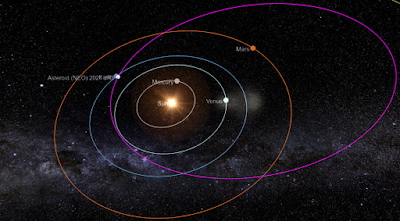Asteroid 2021 JR3 passed by the Earth at a distance of about 779 900 km (2.03 times the average distance between the Earth and the Moon, or 0.52% of the distance between the Earth and the Sun), slightly after 1.55 am GMT on Wednesday 12 May 2021. There was no danger of the asteroid hitting us, though were it to do so it would not have presented a significant threat. 2021 JR3 has an estimated equivalent diameter of 19-61 m (i.e. it is estimated that a spherical object with the same volume would be 19-61 m in diameter), and an object of this size would be expected to explode in an airburst (an explosion caused by superheating from friction with the Earth's atmosphere, which is greater than that caused by simply falling, due to the orbital momentum of the asteroid) betwenn 35 and 5 km above the ground, with only fragmentary material reaching the Earth's surface.
2021 JR3 was discovered on 9 May 2021 (two days before its closest approach to the Earth) by the the Hungarian GINOP KHK dedicated meteor camera system. The designation 2021 JR3
implies that the asteroid was the 92nd object (asteroid R3 -
in numbering asteroids the letters A-Z, excluding I, are assigned
numbers from 1 to 25, with a number added to the end each time the
alphabet is ended, so that A = 1, A1 = 26, A2 = 51, etc., which means that R3 = (25 x 3) + 17 = 92) discovered in the first half of May 2021 (period 2021 J - the
year being split into 24 half-months represented by the letters A-Y, with I being excluded).
2021 JR3 has a 1352 day (3.70 year) orbital period, with an elliptical orbit tilted at an angle of 0.96° to the plain of the Solar System which takes in to 0.74 AU from the Sun (74% of the distance at which the Earth orbits the Sun, and slightly outside the orbit of the planet Venua) and out to 4.04 AU (404% of the distance at which the Earth orbits the Sun, and considerably more than twice the distance at which the planet Mars orbits the Sun). It is therefore classed as an Apollo Group Asteroid (an asteroid that is on average further from the Sun than the Earth, but which does get closer).
See also...



Follow Sciency Thoughts on Facebook.
Follow Sciency Thoughts on Twitter.






